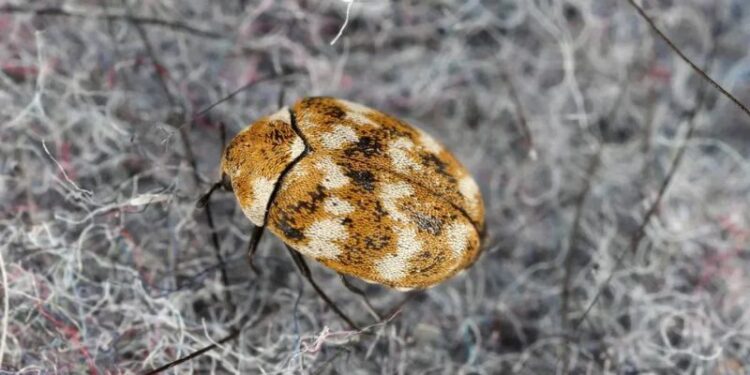Cover insects are a typical family bug that can unleash devastation on your sleeping cushion. Mattresses frequently contain natural fibers like wool, silk, and cotton, which these tiny insects consume. A carpet beetle infestation can cause significant damage to your mattress and other home fabrics if it is not treated. How to get rid of carpet beetles in your mattress in 2023 is the topic of this article. In order to assist you in eliminating these annoying pests and safeguarding your mattress, we will provide detailed instructions, helpful hints, and expert guidance.
How to Identify Carpet Beetles
Carpet beetles are oval-shaped, small insects that range in length from 1/8 to 1/4 inches. They have a varied coloration, including black, brown, white, and yellow. The larvae of carpet beetles are often the culprits behind mattress infestations. These larvae have a bristly appearance and are covered in tiny hairs. They tend to be light brown or tan in color and have a carrot-shaped body.
Signs of a Carpet Beetle Infestation
Before diving into the methods to get rid of carpet beetles in your mattress, it’s crucial to identify the signs of an infestation. Here are some common indicators:
- Adult beetles: Spotting adult carpet beetles crawling on your mattress or other fabrics in your home is a clear sign of an infestation.
- Damaged fabric: Carpet beetle larvae feed on natural fibers, leaving behind irregular holes or chewed areas in your mattress.
- Fecal pellets: Look for small, pellet-like droppings around the infested area. These pellets are a telltale sign of carpet beetle activity.
- Shed skins: As carpet beetle larvae grow, they shed their skins. Finding these discarded skins on or near your mattress indicates an infestation.
Now that we’ve covered the identification of carpet beetles, let’s move on to the actionable steps to eliminate them from your mattress.
How to Get Rid of Carpet Beetles in Mattress in 2023
Step-by-Step Guide to Getting Rid of Carpet Beetles in Mattress
-
Identify the Source of Infestation
The first step in effectively tackling a carpet beetle infestation is to identify the source. Inspect your mattress thoroughly and check for any signs of carpet beetles, larvae, or eggs. Additionally, check nearby areas such as closets, drawers, and carpets for any signs of infestation. Identifying the source will help you focus your efforts and prevent reinfestation.
-
Vacuum the Mattress
Using a powerful vacuum cleaner, thoroughly vacuum your mattress to remove any adult beetles, larvae, and eggs. Pay close attention to seams, crevices, and tufts where carpet beetles are likely to hide. Empty the vacuum bag or canister into a sealed plastic bag and dispose of it outside your home to prevent any escapees.
-
Wash Bedding and Fabrics
Remove all bedding, including sheets, pillowcases, and mattress covers, and wash them in hot water. High temperatures will kill any remaining carpet beetles or eggs. If the fabric is too delicate for hot water, consider dry cleaning it instead.
-
Freeze Infested Items
If you have smaller infested items that can’t be washed, such as stuffed animals or pillows, place them in sealed plastic bags and freeze them for several days. Extreme cold temperatures will kill carpet beetles and their larvae.
-
Apply Insecticides
To further eliminate carpet beetles from your mattress, consider using insecticides specifically labeled for carpet beetles. Follow the instructions on the product carefully and apply it to your mattress and surrounding areas according to the manufacturer’s guidelines.
-
Seal Cracks and Openings
To prevent future infestations, seal any cracks or openings in your walls, floors, and baseboards where carpet beetles may enter your home. This will help create a barrier and make it more difficult for the pests to access your mattress.
FAQs
Q: Can carpet beetles cause health problems?
A: While carpet beetles themselves do not pose significant health risks, their shed skins and fecal matter can trigger allergies in some individuals. It’s important to eliminate carpet beetles from your mattress to maintain a clean and healthy sleeping environment.
Q: Can I use natural remedies to get rid of carpet beetles?
A: Yes, there are several natural remedies you can try to repel or eliminate carpet beetles. These include using essential oils like lavender or eucalyptus, diatomaceous earth, or boric acid. However, keep in mind that natural remedies may not be as effective as chemical insecticides.
Q: How often should I vacuum my mattress to prevent carpet beetle infestations?
A: It’s recommended to vacuum your mattress at least once a month to remove any debris, dust mites, and potential carpet beetle eggs or larvae. Regular vacuuming can help prevent infestations and maintain a clean sleeping environment.
Q: Can I save a severely infested mattress?
A: In most cases, it’s best to dispose of a severely infested mattress. However, if the infestation is localized and not widespread, you may consider hiring a professional pest control service to treat and salvage the mattress.
Q: Are carpet beetles attracted to synthetic fibers?
A: Carpet beetles primarily feed on natural fibers but may also damage synthetic fibers if they are stained or soiled. Synthetic fibers alone are not as attractive to carpet beetles as natural fibers like wool or cotton.
Q: How long does it take to get rid of a carpet beetle infestation?
A: The duration of eliminating a carpet beetle infestation depends on the severity of the infestation and the effectiveness of the treatment methods used. It can take several weeks to several months to completely eradicate carpet beetles from your home.
Conclusion
Dealing with a carpet beetle infestation in your mattress can be frustrating, but by following the steps outlined in this article, you can effectively get rid of these pests and protect your mattress. Remember to identify the source, vacuum the mattress, wash bedding and fabrics, apply insecticides if necessary, and seal any cracks or openings. Regular maintenance and cleanliness are key to preventing future infestations. Sleep tight and beetle-free!

